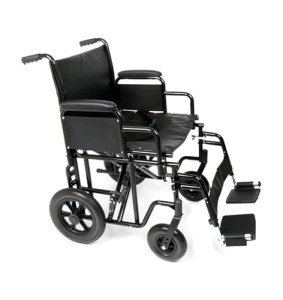Bariatric Transport Wheelchair
Developed to be pressed by caretakers, transport chairs include smaller front wheels and larger rear wheels. They are a popular choice for users with restricted mobility who can not stroll separately.
When shopping for a lightweight bariatric transport wheelchair, think about the user's requirements and how they'll utilize the chair. Also, determine any doorways and other areas the chair will travel through.

Seating
Bariatric transport chairs feature a large 22 to 36 inch broad seating location that accommodates extra-large users. The chair seat is made from breathable nylon and includes padded arms that can be gotten rid of and swing-away footrests. Unlike standard wheelchairs, which are ideal for average body weights, bariatric chairs have actually much heavier frames built from enhanced products and larger rear wheels that make it easier to press them. Speak with a mobility professional to get more information about your options and to figure out which type of wheelchair is best for you. Bariatric wheelchairs are typically covered by insurance coverage service providers like Medi-Cal if your medical condition fulfills their coverage criteria.
Frame
Bariatric transport wheelchairs use sturdy frames made of strengthened products like steel and have larger seats than standard wheelchairs. They are developed for individuals with greater body weights and can hold a maximum weight capacity of 700 pounds. They also have bigger rear wheels, that make them simpler for caretakers to press. Bariatric wheelchairs are typically covered by insurance such as Medi-Cal, depending on the client's specific medical needs and medical diagnosis. Ask a healthcare professional or mobility specialist to help pick the right chair for your special requirements.
Click on this link for more information. Medline Bariatric Transport Chair. just click the following page .
Weight
While basic wheelchairs have lighter frames and smaller sized wheels, bariatric transport chairs include heavier-duty products and a larger seat to accommodate users who weigh more than average. Since of their specialized style and building and construction, they tend to cost more than basic chairs. However, some insurance programs like Medicare and Medi-Cal may cover the cost of these chairs if the user meets the requirements for protection. To learn more about which chair is right for you, get in touch with a rehab expert today.
Wheels
Bariatric transport wheelchairs have bigger rear wheels than standard designs, making them much easier to press. They're often utilized in medical facilities and home settings, where the chair is pushed by caretakers. The extra-large rear wheels likewise enable the chairs to browse a variety of surface, including outdoors.
Basic wheelchairs typically have smaller sized wheels, that make them more maneuverable inside however less suitable for daily use on outside streets and other surface areas. Mobility experts recommend seeking advice from with a healthcare service provider or mobility expert to pick the best wheelchair for your specific needs and objectives.
This durable, nylon strengthened steel transport chair supports clients up to 500 pounds and features a roomy 22" seat, padded desk-length armrests, swing-away footrests and hand brakes. The 12-inch rear wheels make sure a smooth trip in any environment.
